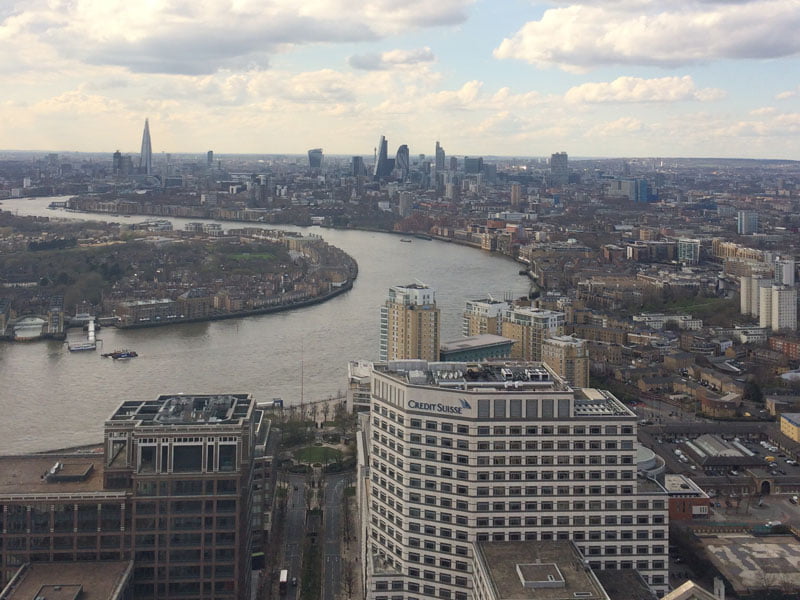The Canary Wharf district east of London, built on old docklands, now rivals the City of London as Europe’s financial centre. The massive complex dates from the early 1990s, and continues to grow as more land is opened for development.
It is a symphony of glass and steel, very unlike the rest of London. Canary Wharf has been one of the largest urban regeneration projects in the world, and you can feel its vibrancy. More than 100,000 people work there.
It is home to the European headquarters of many major financial institutions, including Barclays, Citigroup, Credit Suisse, Fitch Ratings, HSBC, JPMorgan, MetLife, Moody’s and Morgan Stanley.

The tallest building in Canary Wharf, and until recently the tallest in London, is One Canada Square. Towards the top, on the 39th floor, is Europe’s largest high tech accelerator, unsurprisingly named Level39.
Also unsurprising, given its location, is that half the 200 startups operating out of Level39 are in the fintech space. The others are mostly in cyber security, retail and smart city technology.
Level39 was opened by London Lord Mayor Boris Johnson in March 2013. It now occupies three floors of the building, over 7400 square metres. The view is phenomenal, especially on the western side, which offers a panorama of central London, about 10 kilometres away.
Level39 is owned by the Canary Wharf Group, which has become London’s largest property developer. The impressive looking fitout is by leading design firm Gensler, well-known for its work on Facebook’s corporate HQ.
I am in London for only a few days, but I pay a visit to Level39 to get a feel for the place. It’s very impressive. My guide is the Head of Content Asif Faruque, an urbane young Londoner with a background in financial journalism. I asked him about Gensler’s design.
“We asked them to do something between what they did for Facebook and a bank,” he explains. “At Level39 we are helping technology companies supply services to banks, and also potentially disrupt what the banks are doing, so we wanted a look and feel that would encourage that idea.”
There are four levels of membership at Level39. Pantry membership (so-called because it operates out of the extended cafeteria area) is £1500 a year, and a hot desk is £325 a month. A fixed desk, which includes a mailing address, is £525 a month, and a four person office starts at $2600 a month. Larger organisations from 12 to 60 people are also catered for, with the entire 42nd floor of the building given over to a ‘High Growth Space’, launched to meet the demand for larger companies that have grown out of Level39’s accelerator programs.
Level39 also offers a curriculum, where mentors and subject matter experts present seminars on topics of interest to its members. These sessions are not just educational – they act as networking opportunities and as chances to meet potential investors.
“It’s seven hours a week of seminars and workshops and presentations,” says Mr Faruque. “We send out invites, and many of our members get very involved. You have to be quick, as many of them are oversubscribed. The suitability of different sessions might depend on the stage the business is at, as well as the subject matter. We’ve done that since day one – it’s an important part of what we do, a real piece of added value.”
Fintech companies working out of Level39, or which began there, include:
- Behavox – employee monitoring system to spot rogue traders
- Coinjar – a Bitcoin wallet provider that relocated to London from Sydney because of better tax treatment of bitcoins in the UK
- DigitalGenius – artificial intelligence chat engine for companies to talk with their customers.
- Digital Shadows – cyber security threat analysis for financial institutions
- eToro – a ‘social trading’ platform
- Growth Intelligence – uses predictive analysis to indicate the best time to approach a prospect
- Meniga – builds money management apps for banks
- WorldRemit – international money transfer to mobiles.
“The fact that we are located here in the heart of Canary Wharf means that our members have exposure to the heart of the financial industry,” says Mr Faruque. “And the big banks can tap into the talent we have here. Some banks are wary of new technology, but some of them are embracing it wholeheartedly.”
He gives the example of UBS, which is involved with a major cryptographic project. “That’s a real example of a major bank absorbing innovation by proximity. Most of our members come out of the financial community, and the big financial institutions are warming to the idea of what we are doing here.”
Level39 has had a tangible effect on the growth of the fintech startup community in London. Australia’s Stone & Chalk, less than a year old, in many ways models itself on Level39, though it is only a fraction of the size. Fintech is hot, as Level39’s success shows.
Finance is all about technology. It always has been – the money is just a way of keeping score. As technology advances, so does the financial industry. At places like Level39, we glimpse the future.
Do you know more? Contact James Riley via Email.

